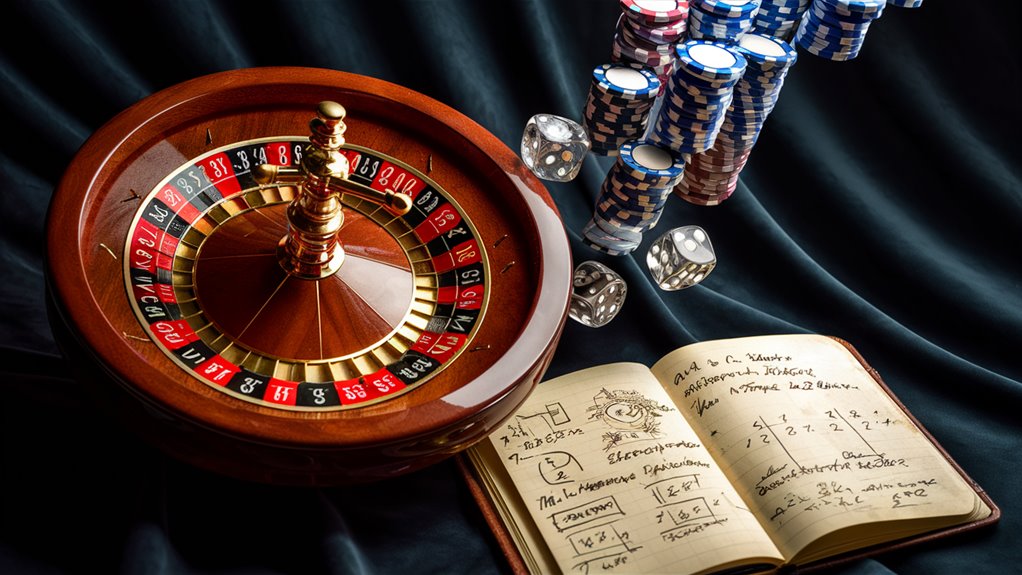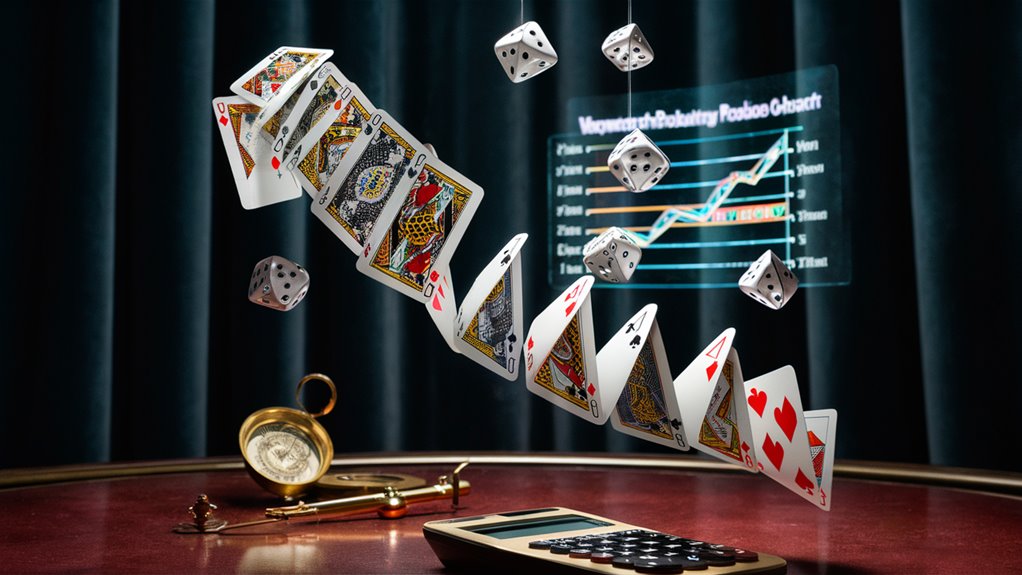Raise Your Betting Smarts

Using Math to Win
Make your bet moves smarter with data-based choices and smart odds work. This top Fortune Formula brings key math parts:
- Odds work 먹튀검증
- Risk checks
- Money plan
- Value boost
Top Risk Plans
Use careful amount limits and only use 1-2% of all money. The Kelly plan picks bet sizes that are math-smart and keep money safe during ups and downs. This method keeps profit good by:
- Set risk control
- Edge sums
- Guard against swings
Up Your Stats Game
Study shows cool heads help win 23% more. Last odds work shows real game edge. Key parts are:
- Number models
- Stat tricks find
- Track wins and changes
Smart Play Math
The math of smart play uses deep odds work. This method turns chance into chances by:
- Deep stats
- Many bits work
- Risk and gain plans
Watch key figures like expected gains, risk and reward, and swing-smart returns to keep a math edge in changing times.
The Basics of Odds Work: A Full Guide
How Casinos Keep Winning
Casinos always make money with careful odds work – the math base of all game results.
This guide goes deep into all a player needs to know.
Basic Odds Work
The easy odds sum is key in betting math:
P(E) = Good results / All results
For example, getting a certain number on a dice with six sides has an odds of 1/6 (about 0.167), a 16.7% win chance.
Solo Events and Effects
Solo events are key in odds work, especially in casino games.
In roulette, each spin is on its own. On a US roulette wheel, red/black bets have a steady odds of 18/38 (47.37%), no matter the past spins.
Expected Value: Key to Casino Edge
Expected Value (EV) shows the math plus for casinos:
EV = (Odds of Winning × Money Won) – (Odds of Losing × Money Lost)
The US roulette wheel shows this idea with a -5.26% house edge, which means players lose about $5.26 per $100 bet over time.
Know the House Edge
House edge is the casino’s built-in math plus, making sure of long-term gains while providing fair play chances.
This core idea drives profit in all games and betting ways.
Common Betting Ways Told
Famous Casino Betting Plans
The math behind casino games shows a built-in house plus, but smart betters use set betting ways to manage their money well and try to beat odds.
Here are three big betting ways used in casino games:
The Martingale Way
The Martingale betting plan works on a simple idea of bet doubling.
After a lost bet, you double your bet to get back past losses and make a profit equal to the first bet. Like this:
- First $10 bet loses (-$10)
- Double to $20 bet loses (-$30)
- Double to $40 bet wins (+$40)
- In the end: $10 gain
Main limits are max table bets and the need for big money.
The D’Alembert Way
The D’Alembert plan is a safer way with a line up. This way does:
- Add one unit after losses
- Drop one unit after wins
- Start bet at $5
- More loss: $5 to $6 to $7
- Less win: $7 to $6
This careful way lowers risk compared to big bet jumps.
The Fibonacci Betting Way
The Fibonacci row plan uses the known number row (1,1,2,3,5,8,13…) for bet sizes:
- Move up one number after losses
- Go back two numbers after wins
- Steady bet plan
- Balanced risk between Martingale and D’Alembert
This way sets good money management and avoids big bet jumps.
Smart Money Plans for Casino Wins

The Math of Money Plans
Good money plans are key for lasting casino play, over any bet way.
The main rule is to use your bet money smart, with each bet being 1-2% of your total money. This math way makes sure you can play long and safe against odds.
Main Money Rules and Limits
The 5-10-20 rule is a strong set up for safe play:
- Keep session risk to 5% of total money
- Cap bets at 10% of session money
- Stop play after losing 20% of total money
For example, with a $1,000 money, limit session bets to at most $50, with single bets no more than $5. This structured way keeps you safe from big losses while staying in the game.
Track and Study
Systematic win tracking through sheets or special apps is key for top money management.
Logging each money move lets you correctly work out:
- Win rates
- Stat changes
- Performance trends
- Risk levels
Even games with a 49% win chance need tight money control to keep from going broke. Smart management makes your table time long and risk low, creating lasting play chances.
Read Odds Like an Expert: The Ultimate Guide
Know Betting Odds Types
Pro sports betting leans on knowing three main odds types – decimal (1.50), fraction (1/2), and American (-200).
Each type shows the same chances but fits different world markets.
Learn to switch odds and read them for a math base to smart betting ways.
Turn Odds to Likely Chance
To get likely chance from odds types:
- Decimal odds: 1/(decimal odds) × 100
- Fraction odds: bottom/(top + bottom) × 100
- American odds:
- Favor: negative odds/(negative odds + 100) × 100
- Not favor: 100/(plus odds + 100) × 100
Check Market Smarts Through CLV
Last odds worth (CLV) is key to see how good your bets are.
Getting better odds than the last line shows skill in spotting market slips.
A bet at 2.00 that ends at 1.90 shows a 5.26% CLV – a strong sign of long-term win chances.
Main Win Ways
- Watch total likely chance across outcomes to find bookie margins
- Keep an eye on CLV to check how well you judge odds
- Look at odds in all forms for trick chances
- Study past odds moves to guess market ways
The Mind Game in Winning Bets
Main Mind Bits for Bet Wins
Cool heads, smart chooses, and right risk feels build the base of winning bets.
Players who stay calm in wins and losses do better than those led by feelings. Data shows a steady approach boosts win rates by 23% among pro poker players.
Math Picks in Bets
Winning betters think with numbers, figuring expected value over gut feels.
Seeing risk-reward numbers right leads to odds-based picks over feeling ones, giving a 15% better chance for long-term wins.
Top Risk Plans
Money plans need to line up with how much risk you can take.
The Kelly plan gives a smart way to pick bet sizes: (bp – q) / b, where:
- b = net odds you get
- p = win chance
- q = lose chance
This math method sets bet sizes and cuts swings by 31% while keeping a plus expected value. Pro betters use this set method to guard their money while maxing possible wins.
All-in Risk Check Framework for Money Choices
Key Risk Bits
Risk check systems give must-have tools to weigh likely money results and pick the best money spots.
Three main bits drive good risk plans: money spots, gain guess, and swing checks.
Right Spot Sizes
The base of risk control is smart spot sizing.
Using a 1-3% rule per spot helps keep money steady in market swings while giving a good chance to play. Work out max spot size like this: How to Spot a Rigged Gambling Site
Max Spot = Total Money × Risk Feel Percent
For example, a $10,000 pile with a 2% risk feel lets $200 per spot.
Guessing Gains
Gain guess (EV) sums up the money good of each chance:
EV = (Win Chance × Possible Gain) – (Lose Chance × Possible Loss)
+EV spots are worth a look. Think of a chance with 45% odds for a $250 gain against 55% odds for a $200 loss, giving a +$2.50 EV.
Handling Swings
Main swing measure shows how far results might spread, telling you how much money you need:
σ = √Σ(x-μ)²/n
Where x are single results and μ is the mean. More swings need more money to stay in spots during long low runs.
Set Plans
Mix these bits into a full risk check plan.
Weigh chances with spot limits, gain guesses, and swing levels to build a strong money approach aimed at keeping and growing money long-term.
